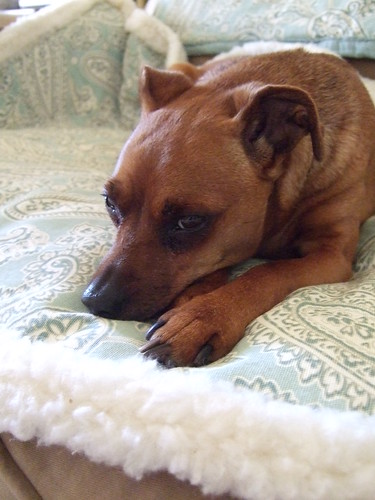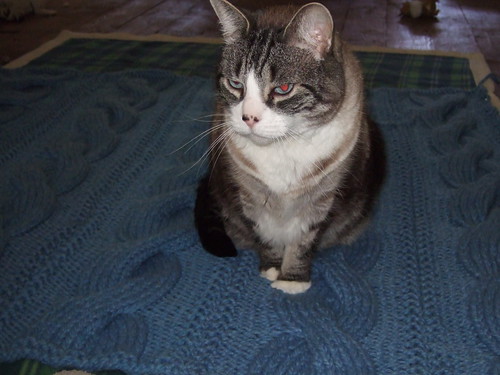Way back in the beginning, when Kevin and I became furry, barking, four legged parents back in 1999 we have always sought out the best (or so we thought) diets they could be on. We thought that buying the leading top, expensive brands (brands like Science Diet, Merrick, Blue Buffalo, Taste of the Wild etc) we were feeding them "healthy foods".
Since Lola was a little peanut she has had skin allergies. So way back in 2002 we put her and Lily (our min pin) on grain free diets. This was definitely a step in the right direction.
Rule number 1. Dogs are NOT meant to eat grains. Their bodies have short digestive tracks and can't process grains. Grains and corn = VERY BAD for dogs. Yet if you look at most "kibble" those are the top ingredients. Why? Because it's a cheap filler, plain and simple.
The statistics are alarming; One in every four dogs will develop some form of cancer. Why is this epidemic occurring? I'm looking mainly at the foods we are provided with in the marketplace. (there are definitely other root causes; pesticides, viruses, age, vaccines, hereditary dna, trauma etc) but I think a very large, if not the largest contributor is what we are feeding our pets.
Ever wonder what "meal" is when you see it listed on the back of a dog food package? Chicken meal, lamb meal, fish meal.. I don't want to completely scare everyone and freak people out - so I'm just going to point you to a website - the shocking truth.. you can read more about the horrors there.
**To give you a little lesson about "meal" the following was taken from here. It was one of the best sources I found to give the information in simple terms*****************************************
The Food and Drug Administration (FDA) defines meal as "the rendered product from mammal tissues, exclusive of any added blood, hair, horn, hide trimmings, manure, stomach and rumen contents." Meal is produced through the process of rendering in which ingredients are ground, boiled, spun to remove the fat, and dried. After rendering, only about 10% water remains allowing the end product to consist largely of minerals and protein (about 50 - 65% protein).
While they can be an excellent source of nutrition and protein, not all meals are created equal.
When describing meal as an ingredient in dog food, the FDA's website states: "In addition to the processing, it could also contain parts of animals one would not think of as 'meat.'"
Generally speaking, a "quality meal" is one for which the source of the ingredient is clearly listed, such as "lamb meal", "fish meal", and "chicken meal". Below are the Association of American Feed Control Officials (AAFCO) definitions of these ingredients:
Lamb meal: "The rendered product from lamb tissues, exclusive of blood, hair, hoof, horn, hide trimmings, manure, stomach and rumen contents except in such amounts as may occur unavoidably in good processing practices."
Fish Meal: "The clean, dried, ground tissue of undecomposed whole fish or fish cuttings, either or both, with or without the extraction of part of the oil."
Chicken Meal: Chicken which has been ground or otherwise reduced in particle size."
Chicken is defined as: "The clean combination of flesh and skin with or without accompanying bone, derived from the parts or whole carcasses of chicken or a combination thereof, exclusive of feathers, heads, feet and entrails"
By-product meals
The AAFCO defines a meat by-product as: "The non-rendered, clean parts, other than meat, derived from slaughtered mammals. It includes, but is not limited to, lungs, spleen, kidneys, brain, livers, blood, bone, partially defatted low temperature fatty tissue, and stomachs and intestines freed of their contents. It does not include hair, horns, teeth and hoofs. It shall be suitable for use in animal food. If it bears name descriptive of its kind, it must correspond thereto."
The most commonly used by-product meal is defined below by the AFCO:
Chicken By-Product Meal: "Consists of the ground, rendered, clean parts of the carcass of slaughtered chicken, such as necks, feet, undeveloped eggs and intestines, exclusive of feathers, except in such amounts as might occur unavoidable in good processing practice."
As a rule of thumb, it is best to steer clear of by-products in your dog's food, whether as a meal or other ingredient.
Vegetable and Grain Meals
Grain and vegetable meals are generally used in dog food to keep the cost of production low. Manufacturers use products like corn gluten meal or soybean meal as an alternative to a more costly and higher quality ingredient.
Soybeans, linseed, and corn may appear as meals in pet food. However, none of these grains are easily digested and are classified as fillers.
Corn gluten meal in particular is commonly used and is a concentrated form of protein that is very difficult to digest. Using this type of ingredient allows the food to advertise high protein content even though your dog might not actually digest or benefit from any of it.
Meat and Bone Meal: "The rendered product from mammal tissues, including bone, exclusive of blood, hair, hoof, horn, hide trimmings, manure, stomach and rumen contents, except in such amounts as may occur unavoidably in good processing practices."
The following is a list of some (not all) ingredients that may be included in the creation of meat and bone meal.
- Tissue from slaughterhouses, including blood, feathers, heads, feet, bones, and entrails
- Restaurant grease and butcher shop trimmings
- Road kill animals, including pets, deer, raccoons, snakes, opossums, foxes, etc.
- Euthanized animals from zoos, vet clinics, or animal shelters, including cats and dogs
- Diseased animals, including those with Chronic Wasting Disease or "Mad Cow Disease"
- Tumor-ridden, cancerous, or "wormy" tissues
- Animal tissues containing drugs or pesticides and injection sites
- Flea collars, ear tags, Styrofoam, and meat wrappers
********************************************************************************************************************************
Now you need to understand not all "meal" is created equal. You need to do your homework before buying any of your pet's foods. We have always read and made sure that none of the foods we feed the girls have any "by products" or "meat meals". You also need to know that while it may still say "chicken meal" or "lamb meal" etc..most of the time, those "meats" still aren't "human grade" and/or fit for human consumption. So think about that as well. If it's not good enough for you to eat it. It shouldn't be good enough for your pets.
But is even the "best" still the best we can give to our pets? Over the years we have changed up our girls diets many times. Making various concoctions with veggies and meats, wet food, dried food, you name it we've given it a shot. But it still feels like we failed.
Our Lily, who passed away in 2009 had been diagnosed with diabetes at the age of 9, we were unable to ever get her fully regulated and within three months had passed away. When we took her into the vet and they were running those final tests they also advised us that she had pancreatic cancer.
Our Mya, a little furball of a kitty, died at the age of 6 from complications with asthma (that she had since she was 2 months old) and then onset of diabetes.
Lastly Enzo, my buddy kitty with bright blue piercing eyes, died at the age of 10, very quickly and suddenly, we were told that he had liver cancer and liver failure.
Now to me, I'm looking at this thinking how could we have such terrible luck? Three of our beloved babies died at very young ages, and now a forth is diagnosed with another form of cancer at the age of 10. How?! How is this possible? We spend massive amounts of money on their diets, we don't allow any chemicals and pesticides into our home or on our grass. How can this be happening when the normal life expectancy for a cat is 15+ years and for small dogs usually 13+. It makes you start questioning every choice you've ever made with them.
So in all our research we have found that Orijen is one of the best pet foods, if you are going to feed your dog kibble, out there. Orijen uses meats that are local to their area, fit for human consumption, the meats have no growth hormone or antibiotics (can you even say that about the meat YOU are ingesting if you are buying it from the supermarket?). Please check out their website if you don't believe me at how amazing this company is and what they put into their foods. This is our number 1 choice for dry kibble.
We also supplement our dogs diet with a raw diet - they get fresh veggies and fruits as snacks and also receive another food each night (that they LOVE). Its by Nature's Variety and it's their frozen raw diet line. They have small little portions that you can easily give your furry friend. The current ones we are feeding the girls this week is the Lamb formula, 95% is lamb and 5% is fruits, veggies, and other whole foods. Here is the list of ingredients: Lamb, Lamb liver, Raw ground Lamb bone, Lamb heart, Lamb kidney, apples, carrots, butternut squash, Ground flaxseeds, Montmorillionite Clay, Broccoli, Lettuce, Spinich, Dried Kelp, dried Apples, Fruit Pectin, Apple Cider Vinegar, Parsley, Honey, Salmon Oil, Olive Oil, Blueberries, Alfalfa Sprouts, Perisimmons, Inlin, Rosemary, Sage, Clove
These two brands for kibble and frozen raw foods are my personal suggestions based on lots of research and personal experience. This is not a sponsored post, we truly believe in these foods and that they really are top of the line in the dog food world.
Come back and see me Saturday for Lola's new diet (no more kibble for her) and explanation of various supplements and herbs we are using for her and her lymphoma. Today I just wanted to share with you foods that we feel truly are the top of the line, healthy foods for your healthy, furry barking friends. But if you have a sick puppy. Please come back and check out my next installment for a holistic diet and supplements that we are having good luck with.
These two brands for kibble and frozen raw foods are my personal suggestions based on lots of research and personal experience. This is not a sponsored post, we truly believe in these foods and that they really are top of the line in the dog food world.
Come back and see me Saturday for Lola's new diet (no more kibble for her) and explanation of various supplements and herbs we are using for her and her lymphoma. Today I just wanted to share with you foods that we feel truly are the top of the line, healthy foods for your healthy, furry barking friends. But if you have a sick puppy. Please come back and check out my next installment for a holistic diet and supplements that we are having good luck with.




